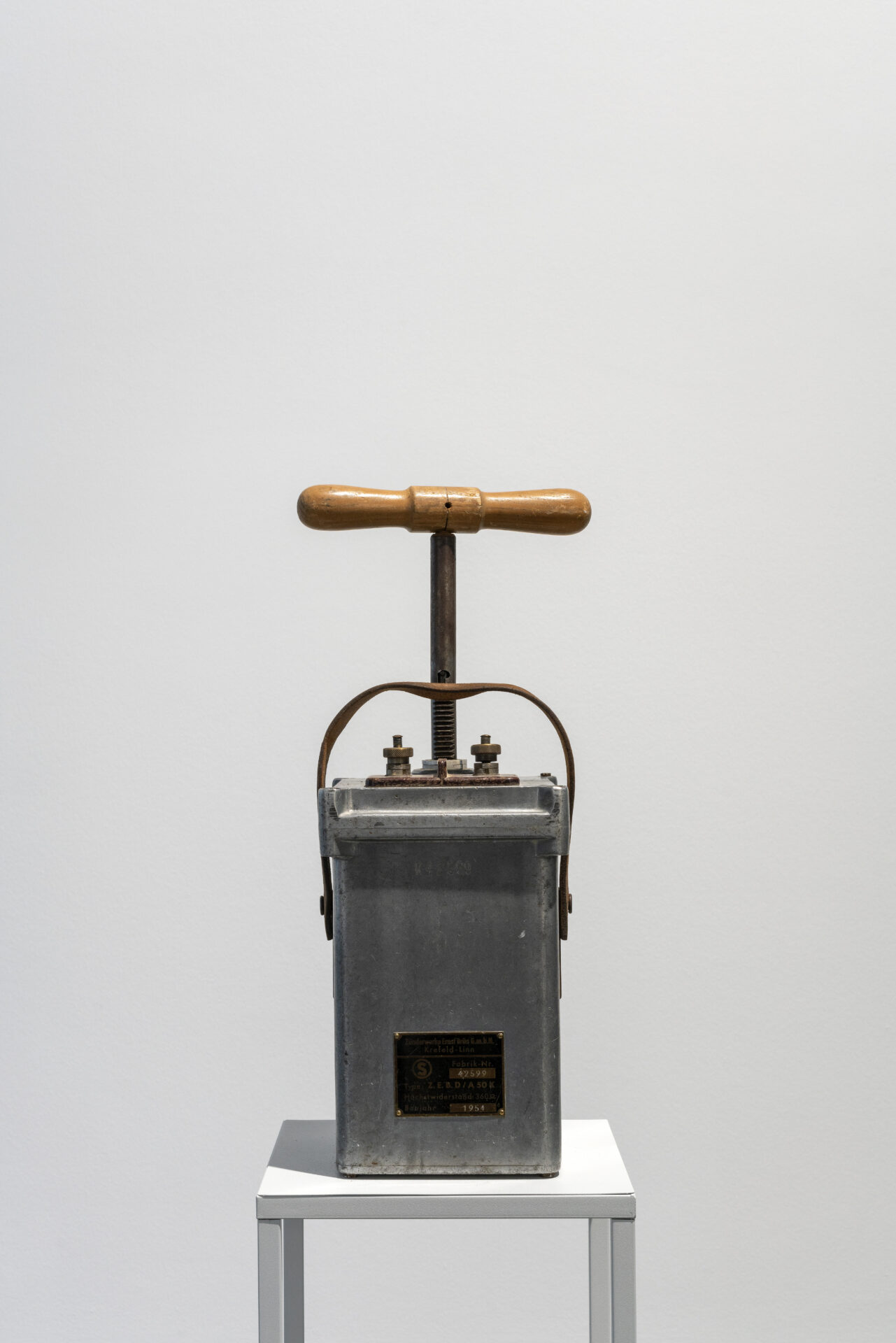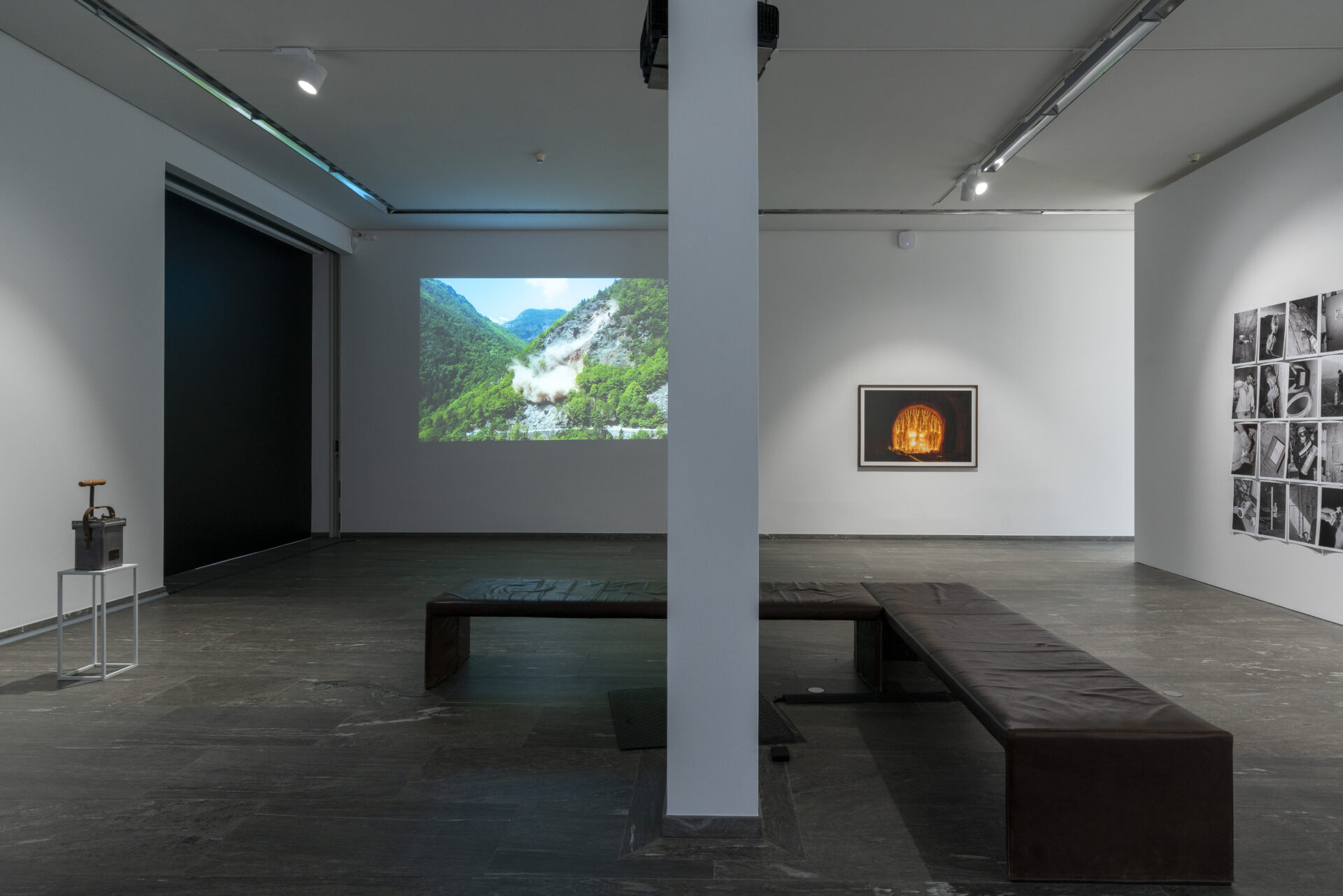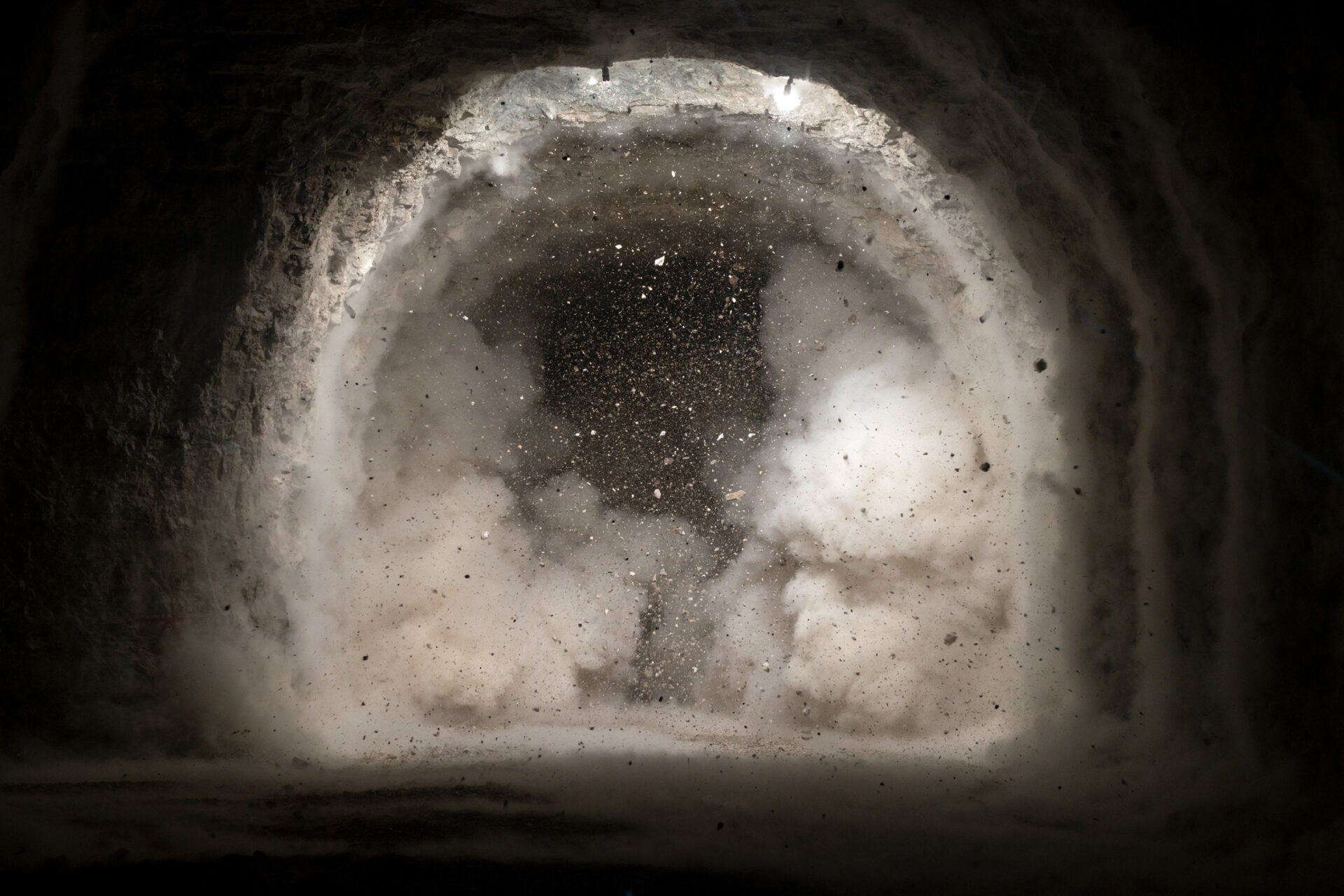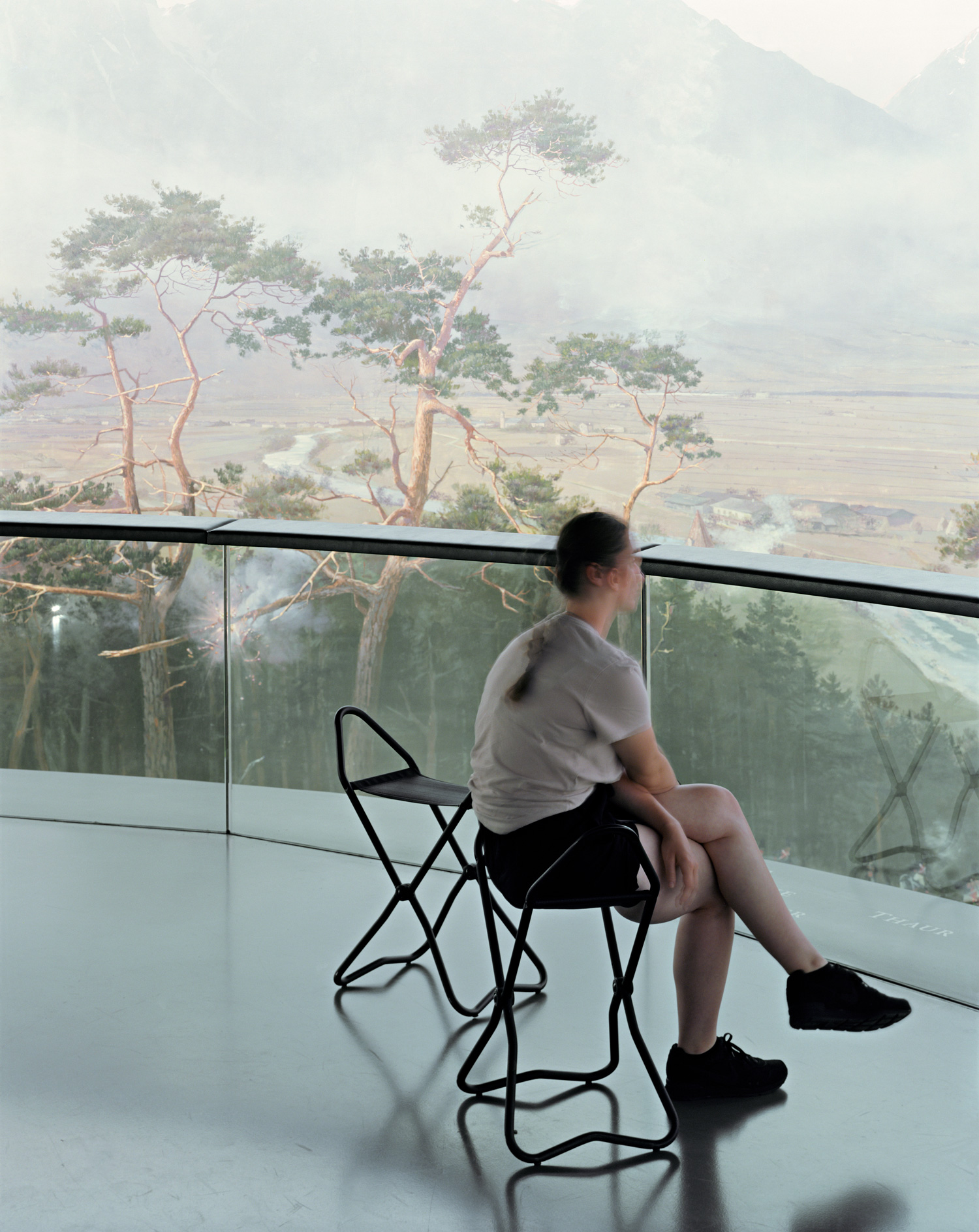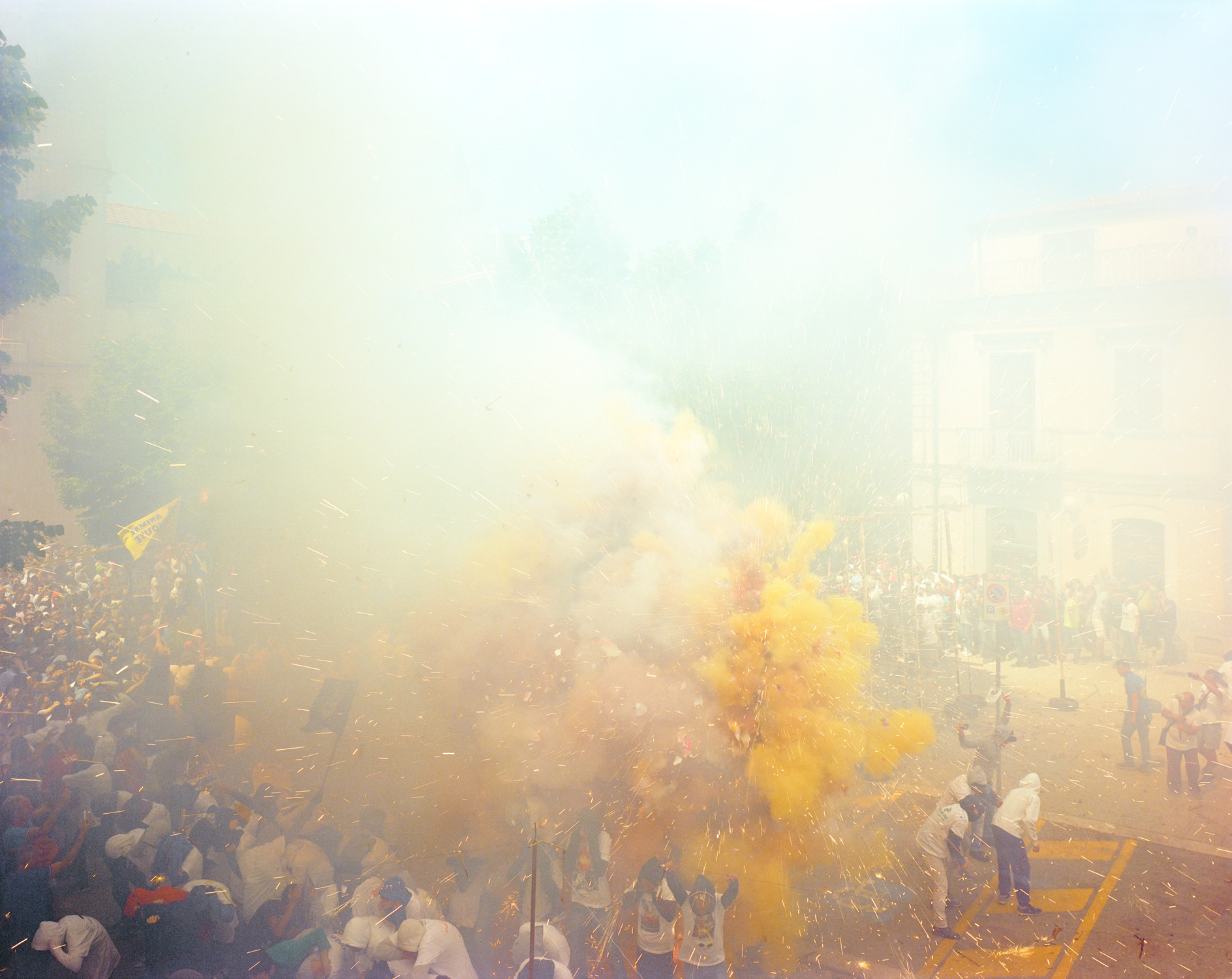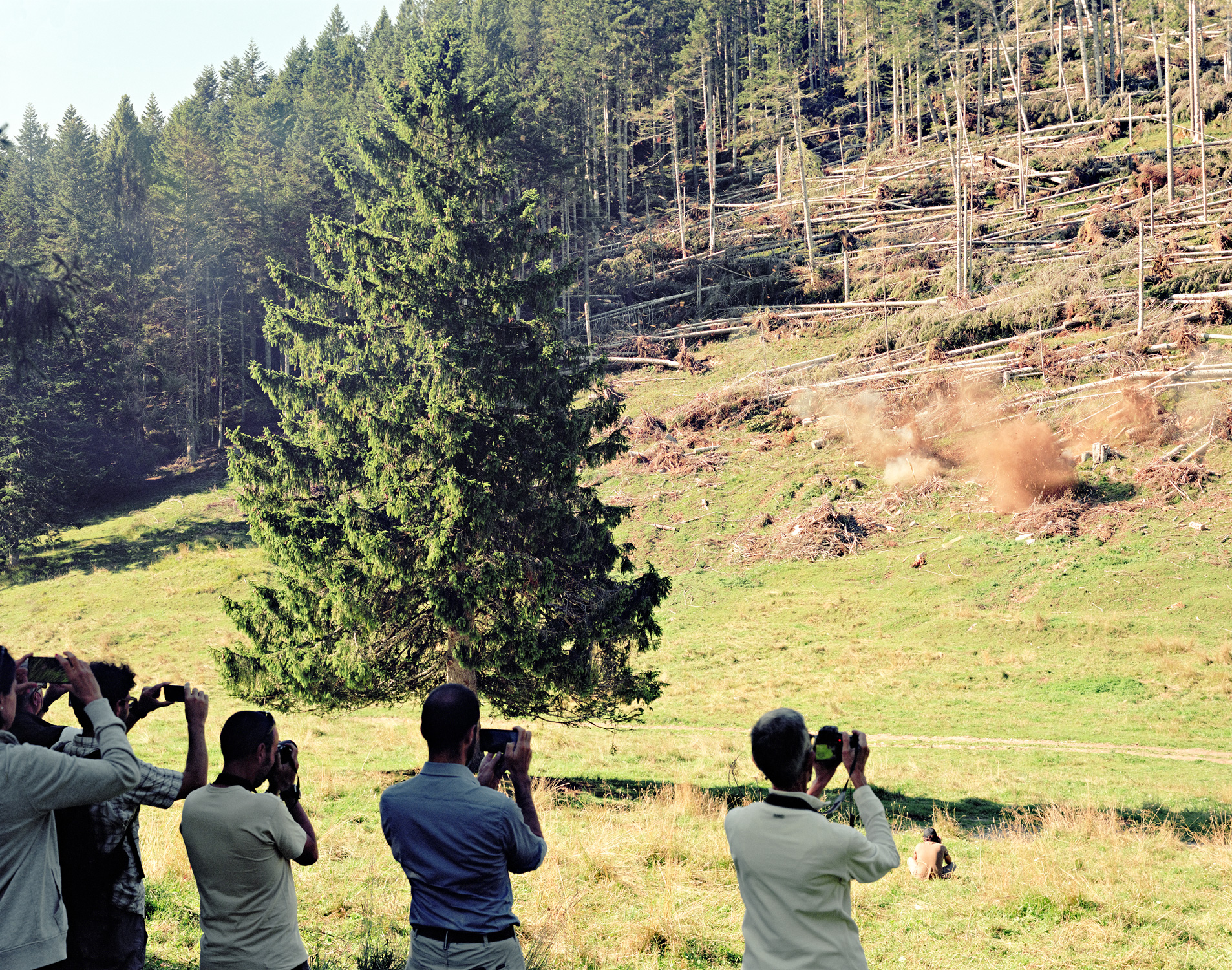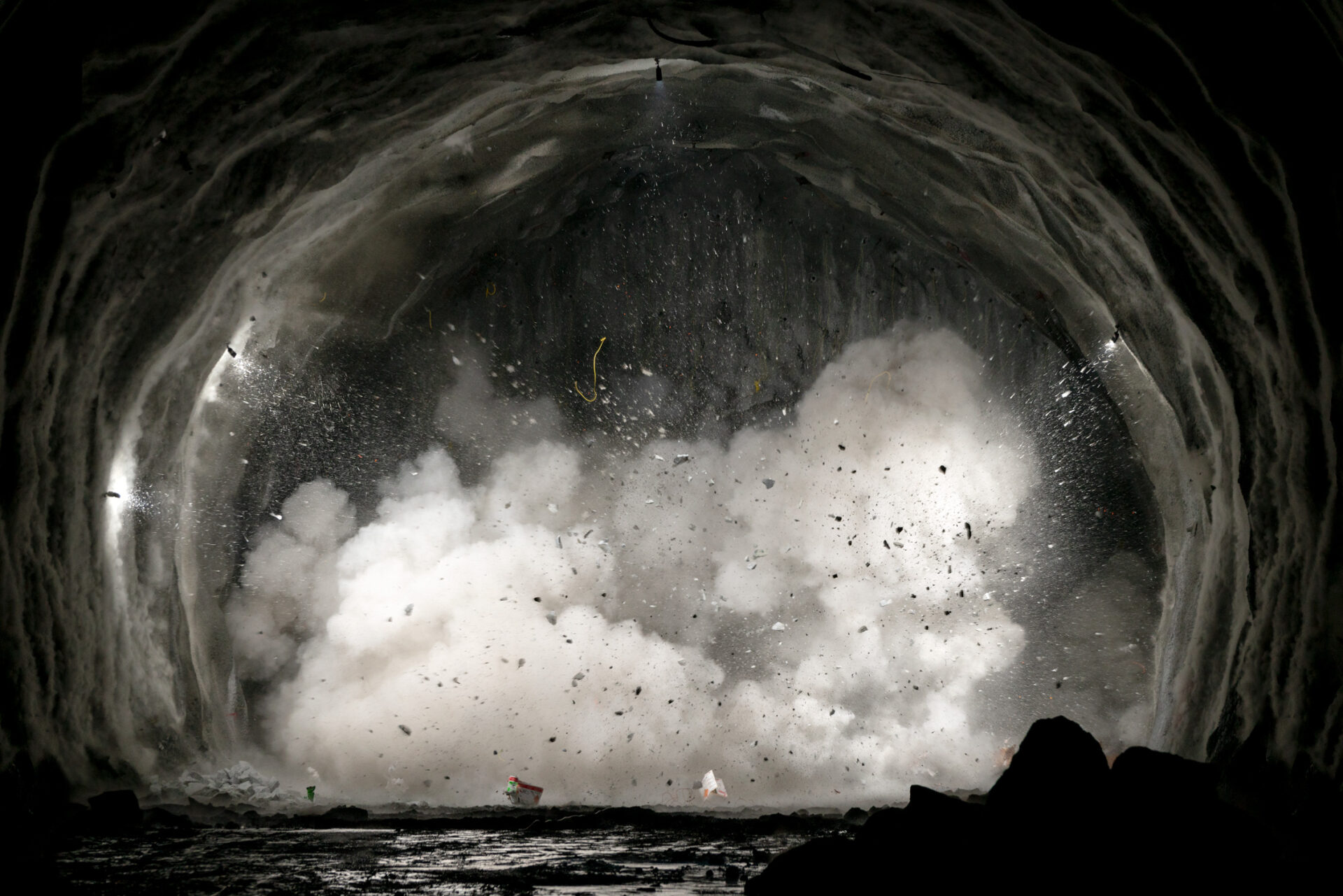Landscape as Performance
Andrea Botto
LANDSCAPE AS PERFORMANCE
curated by Hans-Joachim Gögl
INN SITU – BTV Stadtforum, Innsbruck
4 October 2022 / 21 January 2023
Since 2008, Andrea Botto has dedicated himself continuously to the photography of explosions. As part of the INN SITU series, he was invited to continue this work series in the Tyrol/ Vorarlberg region and this gave rise to new images. Among other places, he visited the Sölden and Silvretta Montafon ski resorts in order to work with the local avalanche experts. He researched ongoing tunnel projects, in particular the Brenner Base Tunnel, and combed the archives for not only historical photographs but also film footage on the subject. Surely one of the most surprising stops on his tour of the region was the Tirol Panorama with its 1,000 m2 cyclorama of the Third Battle of Bergisel in 1809. In addition to his new photographs, the artist will show key works from the many years he has devoted to the subject of explosions.
Presenting this artist’s work in the programme of an art space for contemporary photography is both stimulating and fructifying. Botto’s work offers a kind of culmination point in which many of photography’s key functions and strengths converge. We see landscape photography, but what is being shown here is landscape at the moment of its transformation, dissolution, surrender – the deconstructive antithesis of the visual celebration of romantic sublimity. We experience photographic technology at its essence, in the capturing of an unreproducible moment that would otherwise elude our perception. And, of course, Andrea Botto’s photos are also documentations, the visual recording of the historical events a community of individuals would like to remember for generations. At the same time, however, we are always confronted with a fundamental fascination shared by all, just gazing into a fire or as it were witnessing an explosion: the ambiguously tantalising power of destruction, which can ravage an apartment house with the same technical means as a bomb or connect two countries by blasting a path for an underground railway.
Above all, the photographer sees himself as someone who actively shapes these works. Andrea Botto has a very detailed knowledge of the pyrotechnical processes and responds to them with precise staging strategies and a shooting technique he has developed himself and continues to adapt to his needs and concepts. He knows where to position the camera, getting as close to the action as possible without risking damage to his equipment, and how to release the shutter at the very moment the blasting technician triggers the explosion. A photo shoot of the «landscape shoot». The landscape becomes the photo studio and the subject at once, and the image becomes the artist’s work – beyond the allegedly objective document of an event.
“Pressing the shutter button: this act experienced by the operator
as the release of an energy hitherto compressed,
which was only waiting for the spasmodic moment of its detente”.Arnaud Claass, Le réel de la photographie, Filigranes Editions, Paris, 2012
The Potential Gaze
Andrea Botto in conversation with Hans-Joachim Gögl
Hans-Joachim Gögl: How did the idea of concentrating on explosion photography come about?
Andrea Botto: My cultural background is so-called ‹landscape photography›, but I have never been interested in the simple contemplative act. I have always been attracted to the entropic processes of modification, of dissolution at different time scales, anthropic and geological. I would like to make them visible and observable at the very moment they are happening. I believe in photography as a staging of reality, as an act of the modification of reality, as a way of interrogating the visual and cultural sphere, of triggering an imaginary already present in the mind of the beholder. For me, the subject is always a pretext to undermine the medium and its language. In almost twenty-five years of career, I have photographed the effects of landslides, earthquakes, historical events and demolitions, and from the latter I came to the use of explosives in the civil field. Unique and unrepeatable events, like large theatrical performances, almost instantaneous transformation processes in which a large amount of energy is dispersed and which, once triggered, cannot be stopped. In which the cause is made visible through the effect. Where the anticipation of the event itself, made up of a whole series of projects, studies and technical preparations, becomes part of the creative process in an almost performative way.
HJG: From a photographic perspective alone, this field opens up a great diversity of discourses for you to focus on. One of the irrefutable qualities of photography is, for instance, the ability to capture something that is barely perceptible with the naked eye: the split second of an explosion. Photography as a technique that can visually capture an instant and in this way render it observable.
AB: Yes, the history of photography is punctuated with episodes that have made something visible that had not been so before (even by creating sensational fakes, as in the case of so-called spirit photography, for example). Eadweard Muybridge’s experiments, Berenice Abbott’s scientific photographs or Harold Edgerton’s technological inventions are just some seminal examples of fruitful relationships between art and science, up to today’s augment- ed reality and artificial intelligence technologies. Or even quantum physics, whereby, according to Heisenberg’s ‹uncertainty principle›, which establishes the limits of measurements in a physical system, the very act of observation modifies the observed objects. Again, to speak with the words of Paul Virilio (in his book Art as Far as the Eye Can See), what he calls ‹tele-objectivity› allowed us to see far away in the universe, but to see more doesn’t necessarily mean to see better. What I mean is that there is always something that goes beyond what we see. As the most recent studies in neuroscience tell us, it is our brain that builds the world in which we live. I am interested in a photograph that shows things not only for what they are, but also for what they could be or could have been. A sort of ‹potential› gaze.
HJG: That being said, you have also often been asked to photograph historic events, for example by a company conducting an extraordinary blast. A classic task of photography is documentation, photography as an instrument of memory, and it is an aspect of this medium that you also teach at the art academy in Genoa.
AB: I always start talks about my work or lectures at the Academy of Fine Arts with two fundamental authors from the history of photography who represent two ways of approaching transformation and photography in general. The first example is that of Charles Marville, called to photograph the districts of Paris that would soon be demolished according to the new urban plan created by Baron Haussmann between 1853 and 1870. A precise testimony of the old city recorded for the collective memory of future generations. Thanks to these images we can now see what the city was like, ‹just before its transformation›. The second case is that of Roger Fenton following the English troops during the Crimean War of 1855. In his images we never see the battle but, instead, what remains ‹just after› it. In his most famous photo «The Valley of the Shadow of Death» you can see only a few cannonballs on a road. Beyond everything, however, we can say that both approaches leverage on the congenital ambiguity of the image: it is a document and testimony of what ‹is›, or rather what ‹has been›, and at the same time it is a metaphor of something that goes beyond the visible and which remains hidden or yet to be revealed. Furthermore, I believe that in a lot of contemporary photography there is still some confusion, intentional or not, between ‹documentary photography› and ‹documentary style›. My training is in a certain continuity with Walker Evans’ lesson: «Documentary? That’s a very sophisticated and misleading word. And not really clear. You have to have a sophisticated ear to receive that word. The term should be ‹documentary style›. An example of a literal document would be a police photograph of a murder scene. You see, a document has use, whereas art is really useless. Therefore, art is never a document, though it certainly can adopt that style.» With my work I inevitably clash with the traditions of the past, placing myself in a dialectical and in some ways subversive position. On the one hand I literally undermine the foundations of landscape photography (including all the post-New Topo- graphics evolutions) by putting explosive charges inside the image, and on the other I try to oppose all that twentieth-century rhetoric linked to the myth of the «decisive moment».
HJG: The shaping and in this sense «manipulation» of the image starts long before the actual shooting. Whenever you can, you work closely with the blasters on site and have developed your own techniques to be able to position your cameras as close to the explosion as possible.
AB: When I can, I continue to take part in the design of the explosion, in an increasingly in-depth manner, thanks to my constant collaboration with the experts. At the moment I am particularly focused on the possibilities of experimentation provided by underground blasting excavations. An unusual, fascinating and mysterious place, just because it is difficult to access and mostly unknown to the general public.
Inside the BBT (Brenner Base Tunnel) construction site, thanks to the construction company Ghella, I was able to take the first ever photograph of an underground blast. Thanks to the new project created for INN SITU, I continue experimenting in this field, with a unique and unrepeatable new series of images. The construction of the concrete shelter for the camera, the positioning of the flashlights on the walls of the gallery, the meticulous study of the delay times, the connection of the camera to the detonators, the attempt to predict the final result and to approach it by successive approximations; all these operations make up a single performance which is part of the creative process, becoming itself the artwork.
HJG: Aside from the given historic significance of a blast, for example, your theme also holds an emotional fascination over people: the archaic attraction of fire, collapsing structures, geysers, volcanoes and the uncontrollable forces of nature in general fills us with a sense of both fear and thrill at once.
AB: The terrific beauty of destruction has always attracted men, with a mix of morbidity and fear. Every day we watch the destruction of our world with a kind of indifference or, even worse, with enthusiasm. The explosion is the representation of a dissolution, a perfect metaphor for that destruction. It is a sublime spectacle that attracts and repels at the same time; violent and painful, but perhaps necessary to rebuild and renew. I think I am somehow searching for that point of collapse of the illusion that is well represented by the ‹catastrophe›, a moment of clear transition between a before and an after, which violently and inevitably confronts us with reality, with all its materiality.
HJG: It’s like we are transfixed by the destruction, not yet able to recognize the void, the space that has opened up for the new?
AB: Yes, Albert Einstein defined innovation as «an act of creative destruction», but this concept was born in the economic sphere and derives from the idea that the creative-destructive forces unleashed by capitalism would eventually lead to its disappearance as a system. In philosophy we recall Nietzsche, who said that every creative action has its destructive consequence, and who represents the creative destruction of modernity with the mythological figure of Dionysus. And in Hinduism the god Shiva is simultaneously destroyer and creator. We might also quote Walter Benjamin’s ‹destructive character›, which seems to be very appropriate to this day. It is also true that we say: «Nothing is created and nothing is destroyed, but everything is transformed.» In Nature, destruction is always linked to entropy. Those inevitable cyclical processes of alternation between order and chaos bring us back to the origins of the universe and the myths of creation. However, order and chaos are not antithetical categories but extremes of a space of complexity in which the greatest number of possibilities can take place. The artistic process also acts in this space, and creativity necessarily entails that the artist measure himself with destructiveness, accepting the risk.
HJG: This also brings us to the actual ambivalence of the technology you photograph, one that is used in missile warheads, bombs and mines as well as for tunnel construction or avalanche control.
AB: Since ancient times, man has sought a way to govern the primordial element of fire, bending it to his will. The invention of gunpowder first and of dynamite later made this happen, bringing destruction and progress at the same time. As always happens, it is not the medium itself that is negative or positive, but the use we make of it. I remember that in the historical photographic archive of an armaments company I saw photographs of a tunnel used as a shooting range to test missiles… Obviously, I am totally aware that, even though my works are about explosions made for a good purpose, they can evoke other images of destruction and they can be disturbing in some way. In my images I intentionally look for exactly this disturbing effect. Indeed, I believe this is the prerogative of art. But I think the most disturbing thing is war itself and not the images or words that may call it to mind. It is precisely in historical moments such as the one we are going through that we must try to cultivate critical thinking about what we see and avoid looking away. We have to fight images with other images, on their own ground. Hypersensitivity often leads to censorship.
HJG: Have any of the aspects we have touched upon become more important or less important to you in recent years?
AB: All of these aspects are equally essential, because they have enabled me to get to where I am. What interests me now is dealing with complexity by opposing in every way the idea that it can be reduced to a basic, binary, two-dimensional form. I am not a fan of Zygmunt Bauman, but thinking of his «liquid modernity», it really seems a shame to be content with swim- ming or lying on a mat on the surface. Of course, wearing a diving suit and tanks to go deep costs effort, study, application and is not for everyone. I think of a picture that continues to question me, that doesn’t give me everything right at once, that pushes me to go back and look at it again several times, perhaps discovering something that I hadn’t seen or considered before. I think of a picture capable of creating and maintaining a certain degree of tension.
HJG: The classic Hollywood blockbuster churns out a constant string of the most spectacular explosions possible, all produced using technical means not likely at the disposal of someone doing an artistic photo shoot. How do you deal with this visual benchmark?
AB: I know what you mean and, obviously, there are plenty of movies which were seminal for my work. I remember the spectacular final scene in Michelangelo Antonioni’s Zabriskie Point, as well as Duck, You Sucker! by Sergio Leone or the ironic Hollywood Party by Blake Edwards and the cartoons of Wile E. Coyote and the Road Runner. But what most people may not know is that what we see in the movies are not real explosions but only detonations of various flammable materials. Hollywood is fiction that pretends to be reality. In my pictures there is a reality that looks like fiction sometimes.
HJG: Explosions are just one part of your work. Will you continue to develop this focus in the years to come?
AB: I do not yet see an arrival point on the horizon and this interest could continue for a long time. At the moment I am working on pyrotechnics, in particular on the tradition developed in the Malta archipelago. I’m interested in the material culture and the sculptural dimension of the explosion, its ephemeral and changing plasticity. I am developing new research that creates a relationship between photography, video and ceramic sculpture. I would like to extend this project to other countries in the Mediterranean area where pyrotechnics is applied in very peculiar ways.
Andrea Botto
“Landscape as Performance“
Fotohof, Salzburg 2022
edited by Hans-Joachim Gögl
essay by Riccardo Venturi and Hans-Joachim Gögl
graphic design by Studio Mut
16×22,5 cm
144 pages
softcover
language: German/English
Ed. 500 copies
ISBN: 978-3-903334-43-4



